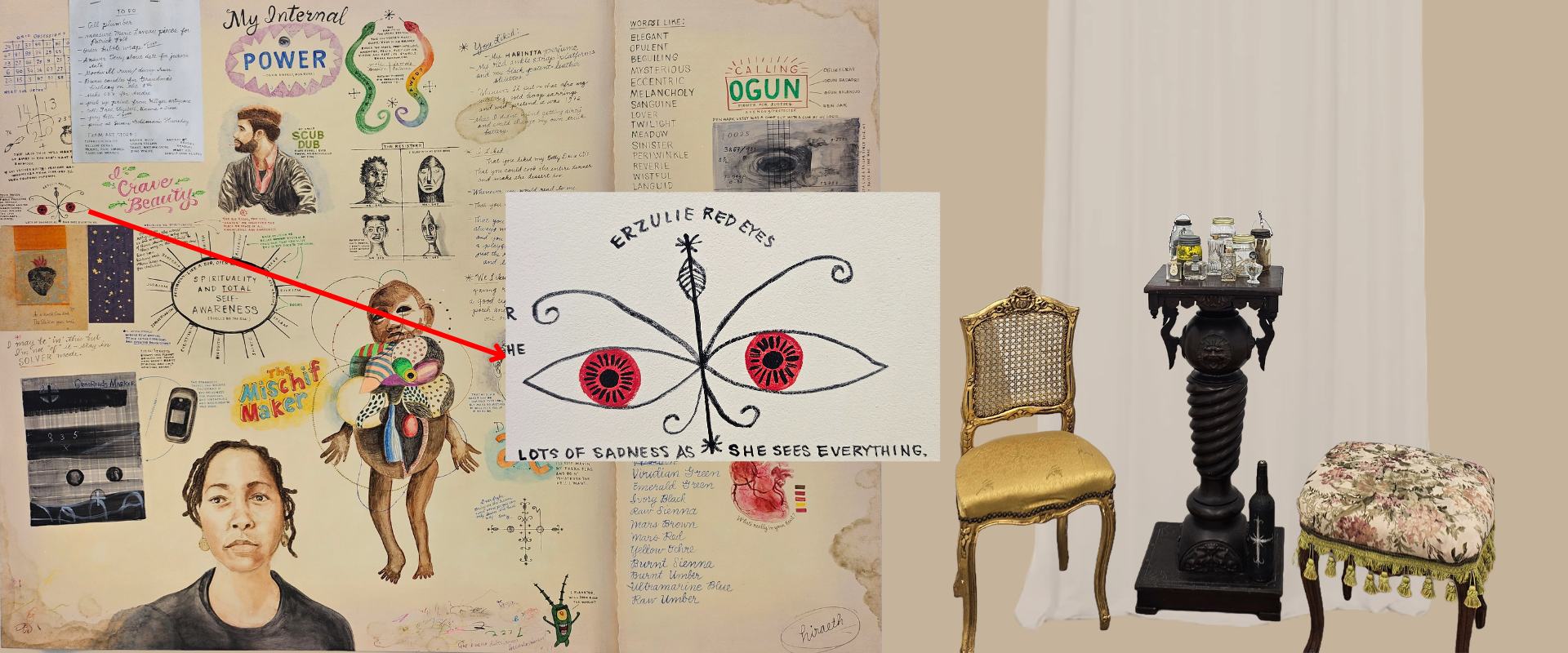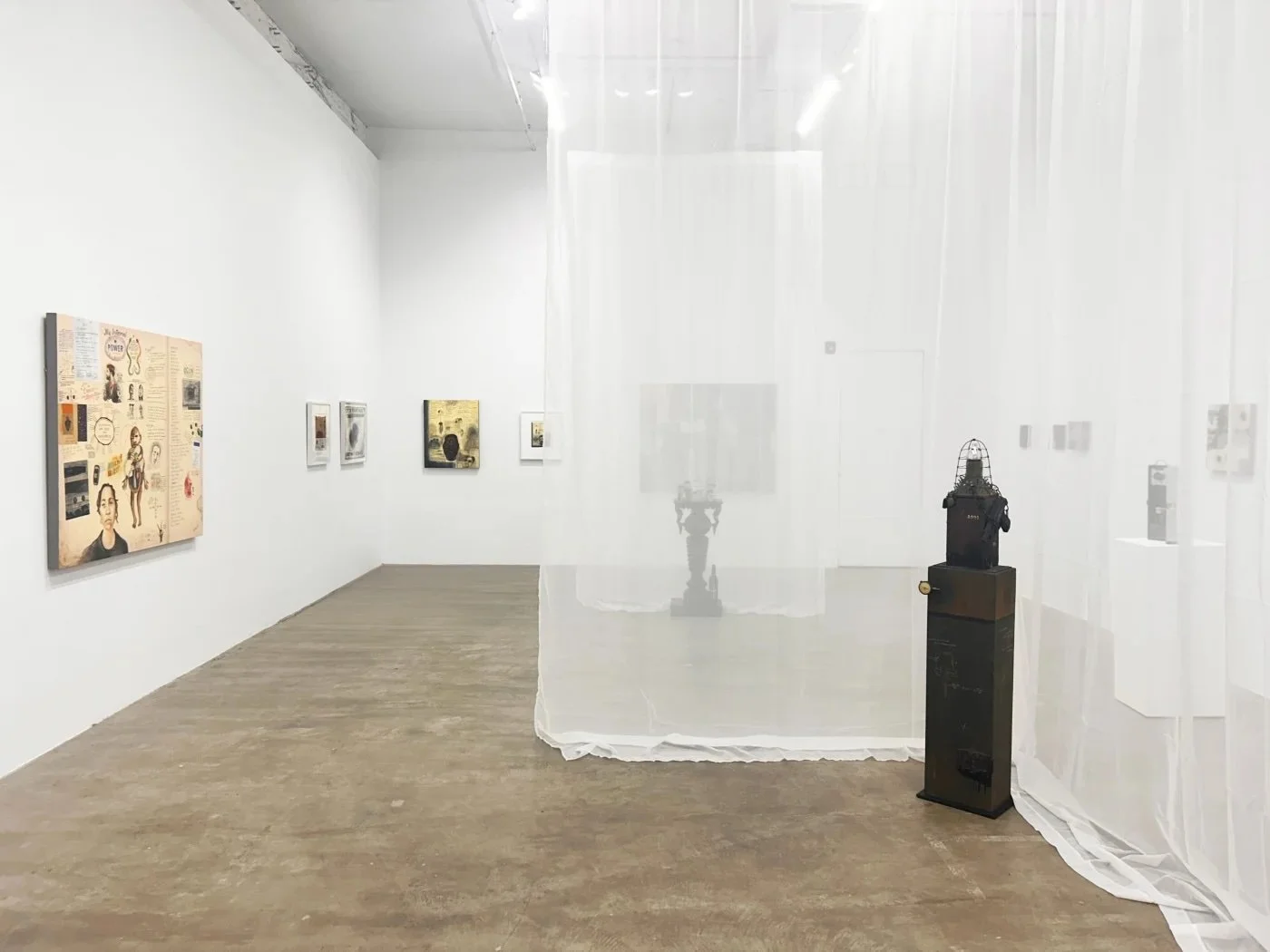Renée Stout Carving Out a Sacred Space
Renée Stout: Truth-telling at Marc Straus Gallery on view until July 12, 2025
Author: Oceana Andries
Renée Stout brings in mystery wherever she is exhibited. When stepping into Truth-telling, the second solo exhibition with the gallery Stout (b. 1958, Junction City, KS), creates an echo chamber of sorts. Here, the audience is initially confronted with a long, white, translucent cloth hanging from the ceiling and obscuring the viewer from the body of work. The fabric acts as a barrier between the rest of the world and the space the artist carved out for her practice. As we pass the threshold, we are spirited away. Stout's introspective thoughts unveil themselves through journal writing about the African diaspora, religion, and art history presented on canvases and in sculptures.
A range of works is on view: acrylic and oil paintings (ranging from 8 × 8 in to 48 × 60 in) and small assemblage sculptures (ranging from 10 x 5 x 4 in to 18 x 5 x 4 ¾ ). Some sculptures appear machine-made, while others are carved wooden figures sourced from the Igbo people of southeastern Nigeria, becoming integral parts of assemblage works. Stout adds acrylic paint and found objects to the figures, adding her idiosyncratic flavor and spiritual flamboyancy.
Four of the presented paintings resemble an aged torn-out notebook page. Some of these ‘pages’ are ruled notebooks with evenly spaced horizontal lines painted onto the canvas, with a pale-yellow tone and painted stains scattered throughout the canvas. The writings on these works grant the viewers insight into Stout’s various observations, “I saw a black rooster – a sign,” from Journal Entry #7 (After the Reading), 2025, and a written list of John Sargent’s palette (from Sketches on Old Paper, 2025). The work also contains objects rendered arbitrarily, accompanied by small personal writings, identical to a researcher's journal.
In "Sketches on Old Paper," a pair of red eyes stare intently at the viewer, accompanied by Stout's note, "Ezrulie Red Eyes. Lots of sadness as she sees everything." Ezrulie is the Vodou Lwa (spirit or Goddess) of love, romance, passion, and sex. She sees the heights of love in its early infatuation and mature iterations, as well as its violent lows, abusive, and cruel. Thus, the redness of her eyes is a physical manifestation representing the burden of her knowledge. Stout renders the attributes of this deity and many others. Throughout her work, we are guided through a pantheon of African diasporic religious figures, such as Ogun and Elegua (also known as Legba), deities from Haitian Vodou, Candomblé, and other religious syndicates, as well as several sigils (religious power symbols) and power objects. Stout shares the recipe for a mojo bag, which is essentially a prayer in a bag; it acts as a portable amulet that can be infused with various energies and herbs depending on the user's needs.
This exhibition once again shows the richness of the artist’s inner world as she shares it with us through her paintings, sculptures, and staging. Stout takes us on a journey through African American folklore and the crossroads of identity and history. Visitors take home a little piece of magic, as we are encouraged to ponder deities, power objects, energy, and ancestry, with them as they exit through the veil and return to their daily lives.
Images: Top image created by Oceana Andries, using works by Ronée Stout on view at Marc Straus Gallery. Other images courtesy of Renée Stout and Marc Straus Gallery.


